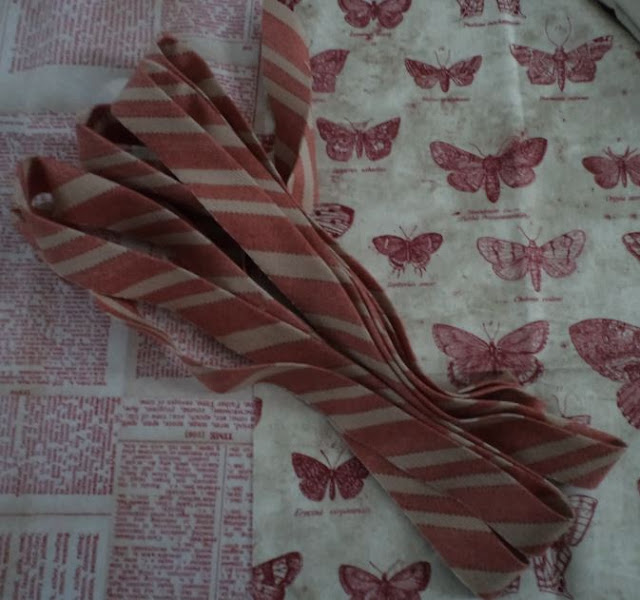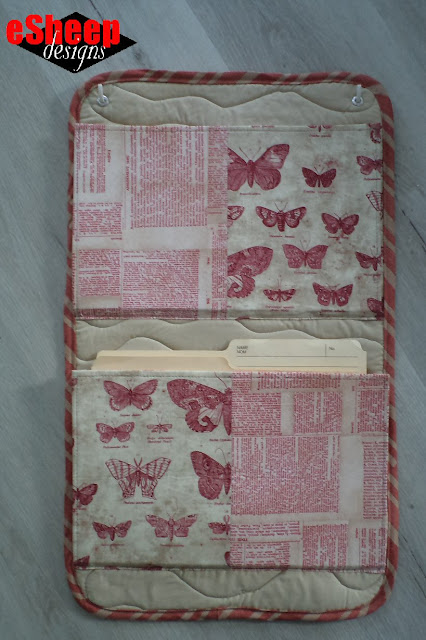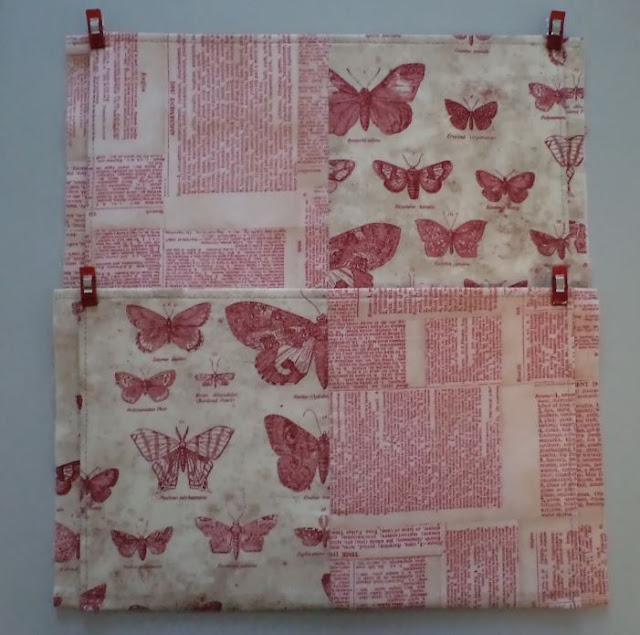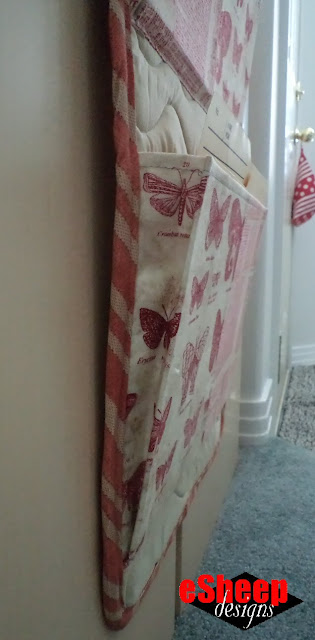 |
| My fabric wall organizer hanging from the side of my desk... |
It's a fabric wall organizer designed by Sara of Radiant Home Studio (link at the end of this post). It's sized to hold regular file folders.
What you see here is my "hacked" version; or, as I prefer to put it, my customized version.
The original uses a lot more Peltex stabilizer and comprises three pockets instead of two. In exchange for not wasting a whole slab of Peltex on the back panel, I chose to put some of my blanket remnants to use and quilt the whole thing instead.
Fabrics are three selections (Dictionary in red, Butterfly in red, and Red and Tan Stripes Ticking) from the Tim Holtz Eclectic Elements fat quarter bundle that I purchased earlier this year, as well as a bed sheet that had previously been used as a bag lining.
 |
| Three Tim Holtz fabrics that were used (the colour of that stripe fabric is a little off in this pic)... |
The stripe fabric was just screaming to be made into bias tape, so that's exactly what was done to it.
 |
| Got about 4 yards of continuous bias tape from a fat quarter... |
Instead of using one fat quarter for each pocket, I decided to bring a bit of symmetry into the design by splitting up the fabric and using half on each pocket. It's a technique that can be helpful when you're making something with just fat quarters. Multiple fabrics can be joined together and then sliced up to create "matching" pieces.
I'm not overly fond of the fabrics in this particular shade of red, but they all go together and — along with the beige-y bed sheet — are a good match for my desk.
Going Smaller & Using Less Peltex
Let me preface by saying that the decision to make the organizer with just two pockets was primarily to avoid a frustrating sewing experience. I absolutely knew that making it in its original dimensions (36" long with three pockets) would be unpleasant, especially if I had to fight with all of the Peltex in the three pockets.
Fortuitously, I wanted this organizer to hang from the side of my desk, which will only accommodate a 24" long version; i.e., one with two pockets.
 |
| Totally happy with how my customized version turned out... |
Even though there was no Peltex in the back of my organizer, it was still a little bit unpleasant having to fold and compress the item while sewing on the pockets. So there you have it, full disclosure: this project had its moments of unpleasantness despite my changes.
[Although, I made a second one that's even more customized and figured out how to sequence the sewing so as to minimize the "scrunching". I'll be turning that version into a tutorial to be posted later this summer.]
 |
| Back view with my crazy quilting... |
For the main panel, I opted to quilt together two pieces of the bed sheet fabric and a blanket remnant, securing the layers with fabric glue. I then slowly quilted from the middle out to the edges.
Way Easier Pocket Construction
Apart from reducing the size of the back panels from 14" wide x 36" high to 14" x 24", I also changed up the dimensions of the pocket pieces slightly.
The original called for a 17" square and a corresponding 1" strip from each fat quarter. I used an 18" square. (Each of which was then sliced in half vertically and sewn to the other with a 1/2" seam allowance to achieve my "matchy-matchy" look.)
 |
| My half and half pocket pieces... |
What was the purpose of the 1" strip? The original pattern instructions had the pocket pieces merely folded in half, top-stitched along the fold and then positioned on the main panel with raw edges exposed along the bottom of the pocket. The 1" strip of fabric was folded into a trim piece that would then be sewn on top of the pocket's bottom edge, to secure the pocket as well as to hide the raw edges.
That seemed like a totally unnecessary extra step, so my solution was to cut the piece larger to begin with (i.e., use the entire 18" available from a fat quarter) and then use that extra inch of material to sew a seam in the bottom.
 |
| There is no rule that says a seam must be located along an edge... |
And speaking of "the bottom", did you know that just because you have a seam, there is no rule that says it must run along an edge? As shown in the picture above, after I sewed the seams and turned the pocket pieces right side out, I rotated the resulting tube of fabric until I found the best looking front side. (Since the other side of this assembly is the inside lining of a pocket, it hardly matters that there is a horizontal seam running across it.)
A piece of Peltex (cut per the original dimensions of 13" wide x 8" high) was then slipped inside this tube, centered left to right, and butted up against the top fold line before fusing. (I only had single sided fusible Peltex, so I put the fusible side to the pocket exterior.) The top edge was then top-stitched and the sides prepared per the original instructions.
The project is fairly easy to put together this way. Once the pockets had been basted along the sides onto the completed back panel, I ran a row of stitching along the bottom edges of the pockets to secure them.
 |
| A less complicated method of finishing the bottom of each pocket... |
Easy-peasy. No need to struggle with keeping long, narrow pieces of fabric in place on top of a large, unwieldy surface.
And for the record, you don't have to worry about the thickness of the Peltex along the bottom because it doesn't extend down that far.

 |
| Side view... |
Again, I found the size of my reduced version daunting enough, having to move this big piece around while trying to stay straight... or curved, as is the case around the corners.
Fortunately, binding is fairly forgiving during the first step of installation. Whenever I found myself slipping away from my intended seam allowance (3/8"), I would literally release the presser foot, move everything back up to where I started to stray and start sewing again. The beauty of it is that this sort of mistake does not show up at all in the final stitching.
Because Peltex is not immune to creasing, I would suggest that if you make this organizer the way it was intended — i.e., the 36" long version with full Peltex backing — you may want to choose fabrics with busy prints that would hide any creases. I steamed and pressed the whole thing after completing it, but I can still see areas on the pocket panels where I know the Peltex had been bent.
The organizer is finished off with a couple of grommets at the top corners.
All that's left is to find some hooks that will fit through the grommet holes. If that's a problem, you could thread a long length of cording through both holes to hang from one hook, or thread smaller lengths of cording through each grommet.
| My "not so great" adhesive hooks... |
These hooks did not hold up the weight of the filled organizer. I ended up removing the adhesive pads and hot gluing them!
Summary of Changes
So, here is a quick rundown of what I changed:
- Reduced length of back panel from 36" to 24" (left the width unchanged at 14") as part of overall change to 2 pocket styling from 3
- Cut my pocket pieces as 18" squares, as opposed to 17" squares with a corresponding 1" strip (note that had I not wanted to split the fabrics in half and join them, I would have cut the fabric at 17" wide x 18" high)
- Sewed a seam into the pocket piece so it could be attached to the back panel directly
- Omitted Peltex from back panel and quilted it instead
I also have two more suggestions. The first is that no matter what size you make this — but particularly if you go for the full size — consider using a nondescript (or recycled) fabric for the back side of the back panel. No point in wasting nice looking fabric for something that will never be seen by anyone, since this hangs against a wall.
Second, take the time to make your own bias tape with a colourful fabric. (Stripes are always a good choice as they become diagonal when cut on the bias.) An interesting binding makes a big difference to the overall appearance of the organizer and — to be honest — allows you to use a relatively plain fabric for the backing. Let's face it, the pockets (and eventual file folders) will hide the majority of whatever fabric you use on the back panel.
What will I be using my file organizer for? Well, my waxcloth folder will have a new home, clearing off some valuable desk space since my Varidesk unit takes up so much of my desktop. In fact, any papers that used to get tossed onto my desk are now put into a file folder. (I just have to remember to look at that stuff on a regular basis.)
In the sewing room, this can definitely be a great option to organize printed PDF sewing patterns.
Or... do you know anyone heading off to college this fall? This would be a useful gift for someone living in a dorm room. Look for a tutorial later this summer for a version that I made for a recent high school graduate.
In the meantime, you can find the particulars for this project on Spoonflower's blog here.

Your crazy quilting looks fabulous, Rochelle. You are really getting into quilting now. Nothing beats homemade bias, and yes, the stripe is a good choice. Good job on using blanket pieces instead of Peltex.
ReplyDeleteI love this so much! Thanks for sharing!
ReplyDelete